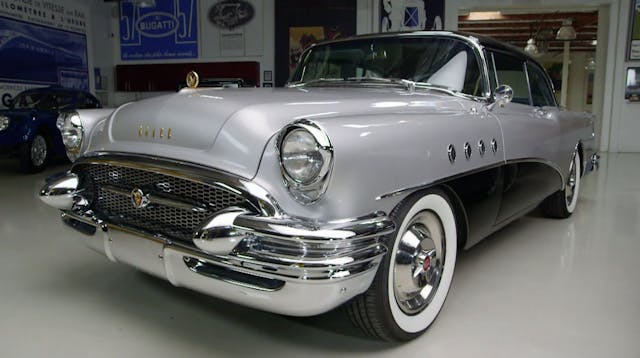Leno: The definition of a hot rod is always evolving

I came to Los Angeles in 1972 to get into show business, and when I landed at the airport, I didn’t have a place to live or a car or anything, so I bought a Penny Saver. There was a 1955 Buick for sale, and it was 3 miles from the airport, close enough to take a cab. The car ran and it was $350, and I didn’t want to take cabs all over town to look at other cars, so I bought it. I drove it for a few years, met my wife in it, and then parked it at my mother-in-law’s house in the early ’80s, where it sat for the next 17 years. One day I went over and there was a note on it that read, “This car has obviously been neglected and nobody wants it, so I would like to buy it.” Deeply ashamed, I brought the car back to the garage, and we did a complete makeover, fitting a GM 572 crate engine and a Corvette C6 suspension. I wanted the Buick to look stock, so we made our own reproduction hubcaps to fit over bigger wheels that had disc brakes behind them.
Is it a hot rod? I guess so, though I don’t think of myself as a hot-rodder. As much as I appreciate the work and talent it takes to chop the roof of an old Mercury down to a letter slot, I prefer stock cars that look like they were designed by guys who went to college, with clean lines and decent ergonomics so you’re comfortable in it and can see out of it. Which is why when we redid a 1966 Olds Toronado in 2004 with rear drive and a twin-turbo GM racing Corvette LS6, we kept the lines completely stock and painted it a stock Toronado color, Trumpet Gold.
To me, that Toronado with 1076 horsepower kind of represents what hot rods were originally, which is cars built out of necessity because there was nothing like them commercially available. Look, young folks have always wanted to go fast and make noise. And the best way to do that (besides riding a motorcycle) is to shove a big engine into a smaller car. But in the old days when hot-rodding took off, the big engines only came from the factory in the big cars, which is why rodders started putting Cadillac engines in ’32 Fords. When the Pontiac GTO came out, GM put the big-car engine in a midsize body and it seemed crazy, though it was exactly what people wanted.
When I was a kid, the real hot-rodders were engineers, or guys whose dads owned transmission shops and they knew everything about cars. Or they were people my dad used to call “hoodlums,” who managed to settle down long enough for somebody to show them how to work on a car. I knew guys in high school who, once they realized that they could fix something, completely changed. They had a skill to take pride in, and they suddenly felt like they had something on the kids who won the science fairs or got scholarships.
Things have changed a bit since then. For one thing, you can now buy crate engines. Used to be you sent your engine out and one guy would bore it, another guy would do the cams, and somebody else would do the pistons and rods, and when it blew up, each guy blamed the other. Now you buy crate engines that drop in and are perfect, much better than what most people can build themselves. And we’ve reached a point where hot rods have gotten somewhat sanitized. I hate when you see a ’32 Ford with an automatic transmission and an adjustable steering column. I’m not saying every rod should have a flathead with three Strombergs on it, but it should have some homemade quality to it.
I love original gauges, though I’m not sure if it’s because they’re beautiful or I’m just nostalgic. And I like when guys do something mechanically interesting, like put Ardun overhead-valve heads on a flat-head. It therefore won’t surprise you that I’m currently doing a restomod of a 1968 Firebird Sprint with the overhead-cam six. John DeLorean loved the Jaguar E-Type and he wanted to build an American version, and this is what he came up with. We’re doing a modern suspension and four-wheel disc brakes, plus a five-speed.
Is it a hot rod? I really don’t know, but let’s talk about it when it’s finished.

